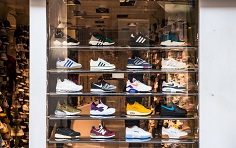ii view: North American sales at JD Sports beat forecasts
Generating most sales in the US and with shares for this FTSE 100 company down around a third over the last year. We assess prospects.
27th August 2025 11:38
by Keith Bowman from interactive investor

Second-quarter trading update to 2 August
- Like-for-like sales down 3%
Chief executive Régis Schultz said: “We are making strong progress in developing our omnichannel customer proposition, store footprint and supply chain, and we are controlling our costs and cash effectively.
“We are well placed to continue growing our market share in the key growth regions of North America and Europe, and confident about the medium-term growth prospects for our industry.”
- Invest with ii: SIPP Account | Stocks & Shares ISA | See all Investment Accounts
ii round-up:
JD Sports Fashion (LSE:JD.) today detailed better than expected sales for its biggest North American market with the global sports retailer underlining confidence in the medium-term outlook via a new £100 million share buyback programme.
Second-quarter like-for-like North American sales fell 2.3%, beating estimates for a fall of 5.3% and aided by new footwear launches deferred from the first quarter, and improving apparel and online trends. Investments in online product pricing left the overall profit margin down 0.6% over the first half, although with management hopeful of meeting current full-year City profit forecasts while monitoring US trade tariffs.
Shares for the FTSE 100 company rose 4% in UK trading having come into this latest news down by around a third over the last year. Shares for supplier adidas AG (XETRA:ADS) are down by a quarter. The FTSE 100 index is up 11% over that time.
JD Sports operates 4,872 stores and a series of websites across North America, Europe, the UK and Asia Pacific. In April, the Bury-headquartered company outlined a new strategy to focus on profits and shareholder returns given the backdrop of slower sales, as well as anticipated slower future sales.
Groupwide like-for-like sales fell 3%, down from a fall of 2% in Q1, and hindered by tough comparisons across the UK and European businesses given the football Euros tournament a year ago.
Accompanying management outlook comments flagged second-half caution due to strains on consumer finances, potentially rising unemployment and the indirect impact of US trade tariffs on suppliers.
First-half results are scheduled for 24 September.
ii view:
As well as JD Sports itself, other group store brands include Finish Line, ShoePalace, Sprinter, as well as outdoor UK brands Blacks, Millets and Go Outdoors. Footwear generates most sales at 60%, followed by apparel at 31%, accessories 6% and outdoor equipment and gym memberships the balance of 3%. Geographically, North America accounts for most sales at 36%, followed by Europe at 34%, the UK 26%, and Asia Pacific the balance of 4%.
For investors, the importance of major sporting events in generating sales should not be forgotten. Pressured consumer spending and slower product innovation by suppliers are more broadly contributing towards slower sales. JD’s relationship with sporting goods makers Nike and Adidas warrants consideration, with each also targeting their own online sales direct to consumers, while a forecast dividend yield of 1.1% compares to forecast yields of over 3% at fellow retailers Tesco (LSE:TSCO) and B&Q owner Kingfisher (LSE:KGF).
- Shares for the future: new ranking for this FTSE 100 stock
- 10 hottest ISA shares, funds and trusts: week ended 22 August 2025
- Insider: buying at FTSE 100 stock where selling is overdone
More favourably, management actions to improve performance, including more focused marketing, pushing cost savings from previous takeovers and selectively investing in product pricing, are ongoing. Brand and geographical diversity persist. An estimated share price to net asset value comfortably below the three-year average suggests improved value, while previous M&A moves in the US could open the door to further sector activity going forward.
In all, a refocus by management on profits and shareholder returns offers longer-term hope. That said, more cautious investors may decide to await more concrete signs of recovery before taking any interest.
Positives:
- Diversity of product, brand name and geographical location
- Management actions to improve performance
Negatives:
- Uncertain economic outlook
- Subject to currency movements
The average rating of stock market analysts:
Buy
These articles are provided for information purposes only. Occasionally, an opinion about whether to buy or sell a specific investment may be provided by third parties. The content is not intended to be a personal recommendation to buy or sell any financial instrument or product, or to adopt any investment strategy as it is not provided based on an assessment of your investing knowledge and experience, your financial situation or your investment objectives. The value of your investments, and the income derived from them, may go down as well as up. You may not get back all the money that you invest. The investments referred to in this article may not be suitable for all investors, and if in doubt, an investor should seek advice from a qualified investment adviser.
Full performance can be found on the company or index summary page on the interactive investor website. Simply click on the company's or index name highlighted in the article.